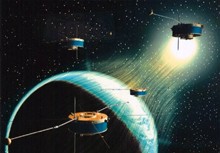Summary
A Study of Small-Scale Plasma Structures and Processes
The Cluster mission was first proposed in November 1982 in response to an ESA Call for Proposals for the next series of science missions. The idea was developed into a proposal to study the 'cusp' and the 'magnetotail' regions of the Earth's magnetosphere with a polar orbiting mission. The Cluster idea developed into a proposal and then a mission. In 1996, Cluster was ready to be launched.
Cluster was expected to benefit from a 'free' launch on the first test flight of the newly developed Ariane-5 booster. After several minor delays, Ariane-501 lifted off from Kourou, French Guiana on 4 June 1996, carrying its payload of four Cluster satellites. Unfortunately, the launcher's maiden flight lasted just 37 seconds before intense aerodynamic loads resulted in its break up and initiation of the automatic destruct system. Debris from the Cluster spacecraft were scattered across the mangrove swamps near the launch site.
It seemed to all concerned that 10 years of work had come to nothing. However, in July 1996, after considering possible ways of recovering at least some of the unique science from the mission, ESA decided to build a fifth Cluster satellite. Appropriately named 'Phoenix', after a mythical Arabian bird that was burnt on a funeral pyre and then was reborn by rising from the ashes, this spacecraft was to be identical to the original Cluster spacecraft. It would be equipped with flight spares of the experiments and subsystems prepared for the Cluster mission. New equipment would only be manufactured when necessary. By taking advantage of the existing hardware, together with the knowledge and experience gained in the original programme, Phoenix was expected to be fully integrated and tested by mid-1997, opening the way for a launch later that year. This rapid response to the launch failure soon gave way to a longer term strategy.
An awareness that the scientific objectives of the Cluster mission could not be met by a single spacecraft led to proposals to rebuild three or four full-size Cluster spacecraft alongside Phoenix. Although these proposals had significant implications for an ESA science budget that was already fully committed, it was accepted that the costs of a full rebuilding programme would be much lower, since the spacecraft had already been through a complete cycle of design, development and testing. The aim was for completion so that they would be available to study the Sun during the peak of the solar cycle, which was expected in the year 2000.
The Ariane-5 was now considered too expensive for the project and it seemed that there was no solution to meet the stringent cost cap imposed by the Science Programme Committee.
 |
|
Artists impression of Cluster quartet entering the shadow of the eclipse. |
Only at the last minute, in the morning of the SPC meeting, Arianespace suggested to look at the possibility of using the Russian Soyuz rocket to launch the spacecraft. The newly created Starsem, a European-Russian venture between Aerospatiale, Arianespace, the Russian Space Agency and Samara Space Center, was starting to market the Soyuz rockets. In view of this new launch option, the SPC was asked exceptionally to delay the decision by four weeks, the time to make a preliminary study on the launch with Soyuz.
The preliminary study showed that the performance of Soyuz were perfect for Cluster II and after a few weeks of negotiations with Starsem, the cost for two rockets could be kept under 60 MECU. In the meantime, the Principal Investigator, had identified the payload costs and during the SWT on 26 February, ESA made the offer to support part of the payload costs. The two problems were finally solved.
On 3 April 1997, the SPC approved the recovery mission for a total cost of 214 MECU, including the launch on board two Soyuz rockets and the support of the scientific payload at a 40% level.
On 28 November 1997, the contract to provide four Cluster II spacecraft was signed with the Prime Contractor Daimler Benz Aerospace (Dornier), Germany and on 24 July 1998, the contract for the launch was signed with Starsem. When the first Soyuz blasted off the Baikonur Cosmodrome on 16 July 2000, Cluster was starting to rise from its ashes. It was, however, not until the second launch on 9 August 2000 and the proper injection of the second pair of spacecraft that the Cluster mission was back on track. Cluster is fulfilling its promise to be a revolutionary magnetospheric space mission. The four-point, relatively closely spaced measurements with identical instruments have already yielded unparalleled views of space plasma processes in key regions of the magnetosphere and in the near-Earth, upstream solar wind. Magnetospheric phenomena are clearly seen to have a rich complexity that could only be suspected.
